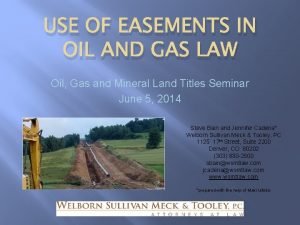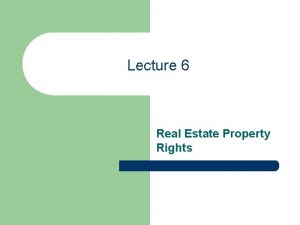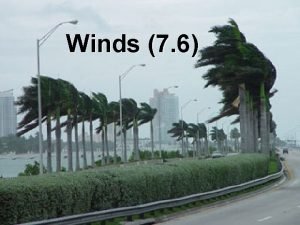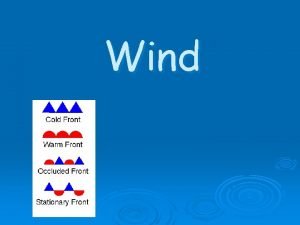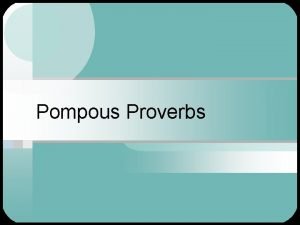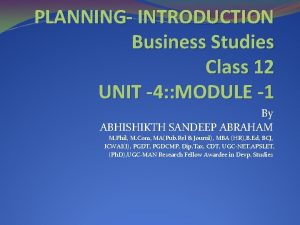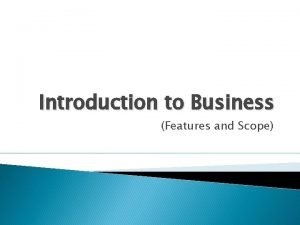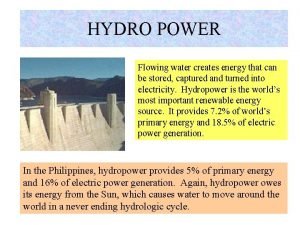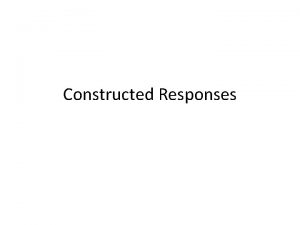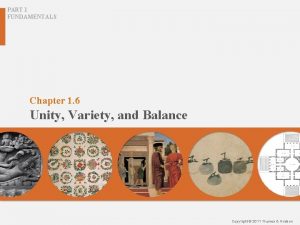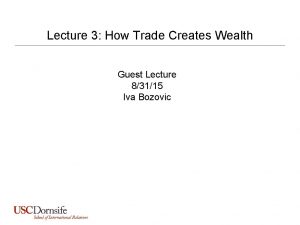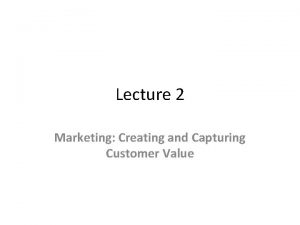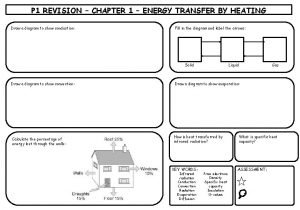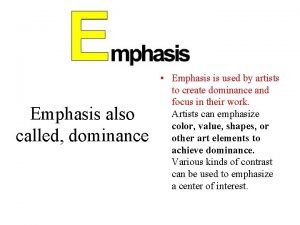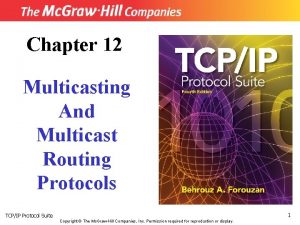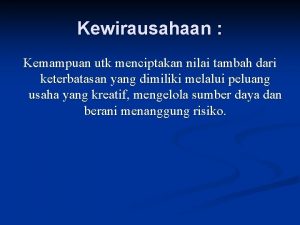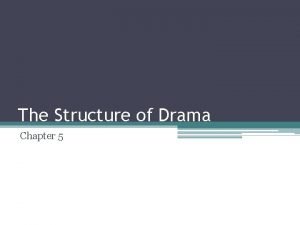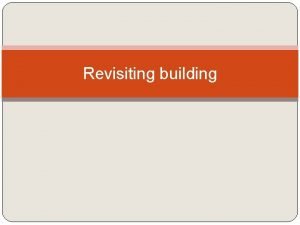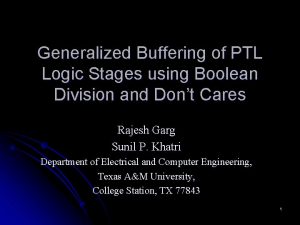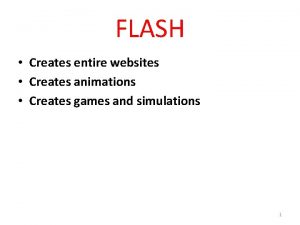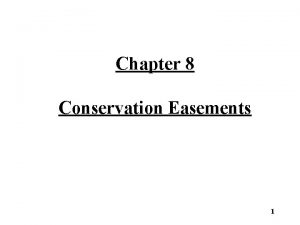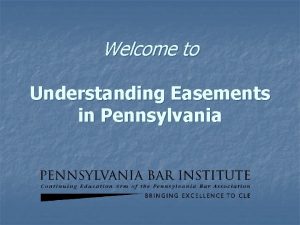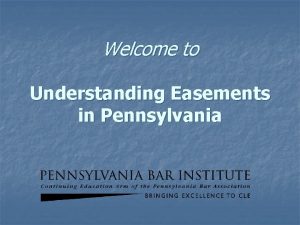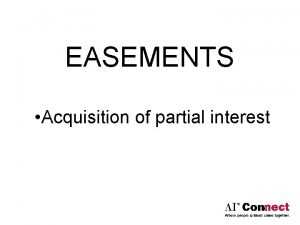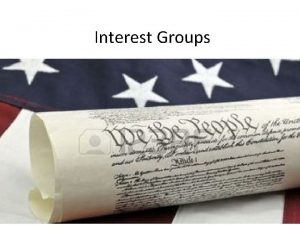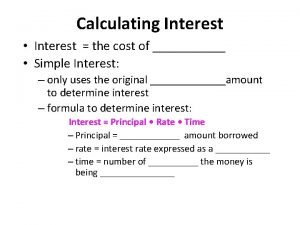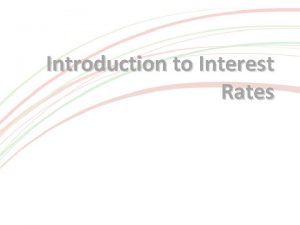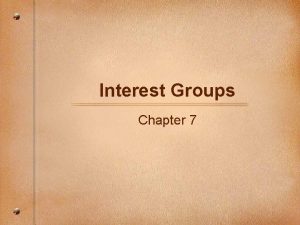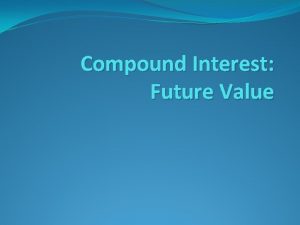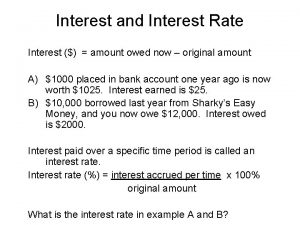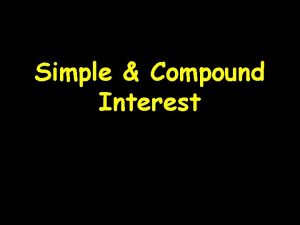Easements EASEMENTS Definition Nonpossessory interest that Creates a













































- Slides: 45

Easements

EASEMENTS Definition Non-possessory interest that Creates a right to use land possessed by someone else. Common Examples Utility line Right of way

Easements Types of Easements § Affirmative Easement Ex: § Right of way (affirmative use) Negative Easement (restrictive covenant? ) Ex: Light; air; artificial stream Easement Appurtenant Requires dominant and servient tenements (attaches to land) Transferable conveyance! Parties Easement No regardless of whether it is mentioned in the take subject to easements in Gross dominant estate (personal) Inalienable unless used for commercial purpose

Easements Creation of Easements (PINGER) Prescription Implication Necessity Grant (express) Express Reservation

Creation of Easements Prescription (ONCHA) (Adverse Possession) Open & Notorious Visible pattern of use Can be discovered upon inspection Continuous Dependent upon property Constant use unnecessary Tacking is permitted Hostile (Adverse) Use without permission Need NOT be exclusive Example: Driveway Actual Gives notice *Negative easements cannot arise by prescription

Creation of Easements Implication Estates held in common ownership at time easement created, AND Previous use was apparent and continuous Parties intended use to continue after division Reasonable necessity for use and enjoyment Example: Sewer drain

Creation of Easements Necessity As (Implication) a result of severance of property, Parcel Must becomes land-locked be absolutely necessary. Example: mountain range, water

Creation of Easements Grant (express) Grantor expressly conveys easement An easement to endure for more than one year must satisfy Statute of Frauds (PLWWS) Parties (ID grantor and grantee) Land Writing Words of sale Signed by Grantor (holder of servient estate)

Creation of Easements Express Reservation Owner of present possessory interest conveys title but reserves the right to continue to use land for a specific purpose after conveyance Majority Can View: only be reserved for grantor, not third party

Scope of Easements If language of grant explains easement scope grant governs If grant does NOT explain easement scope Reasonable interpretation! Cause of action for exceeding scope: Injunction

Scope of Easements “Reasonable Interpretation” Presumption Easement holder entitled to do what is reasonably necessary to use and enjoy land Location and Use Determined by any prior use or how easement reasonably expected to be used (for size and use) Reasonable changes to accommodate normal development (Ex: buggies cars) Intensity of Use Will not be overburdened unless beyond reasonable contemplation of parties Subdivision: Every new lot owner entitled to use pre-existing easement Reasonable: 5 Unreasonable: 100

Termination of Easements CD SCRAPMEN Condemnation Destruction Stated Conditions Release Abandonment Prescription Merger Estoppel Necessity

Termination of Easements Condemnation of servient estate terminates easements

Termination of Easements Destruction If easement is structure (e. g. staircase), involuntary destruction of easement structure will terminate easement Voluntary easement destruction does not terminate

Termination of Easements Stated Conditions created within original creation of easement will be honored Ex: “as long as road is maintained” “while A lives at 123 Main Street”

Termination of Easements Release Easement holder releases interest (i. e. conveys) to servient estate holder Must meet same SOF requirements as creation of easement (PLWWS)

Termination of Easements Abandonment Easement holder demonstrates by physical action an intent to permanently abandon easement EX: Easement holder builds house on right of way Mere words insufficient Mere non-use insufficient

Termination of Easements Prescription Servient estate holder interferes with easement so as to create cause of action in favor of easement holder Must be “ONCHA” for the statutory period

Termination of Easements Merger One person comes to own both dominant and servient estate No revival, even if later sold to third party Complete unity required Interest in servient estate must be equal to or greater than duration of easement EX: A owns parcel in fee simple. A grants B an easement across A’s parcel and the duration of easement is in fee simple. A conveys A’s parcel to B. Complete unity exists easement is terminated NON-EX: A owns parcel in fee simple. A grants B an easement across A’s parcel and the duration of easement is in fee simple. A conveys 10 -year term tenancy in A’s parcel to B. No complete unity exists easement is NOT terminated

Termination of Easements Estoppel Requirements Conduct or assertion by easement holder; Reasonable reliance by owner of servient tenement; AND Change of position by owner of servient tenement.

Termination of Easements Necessity For If easements created by necessity… necessity ends then easement ends

Licenses vs. Easements *The following slides will focus on the differences between licenses and easements

Licenses vs. Easements Definition Non-possessory interest that entitles holder to some use/enjoyment of land Licenses Privilege for holder to enter another’s land for a delineated purpose

Licenses vs. Easements Examples Right of way Utility lines Restriction of tree height Licenses Delivery person Plumber Party guest *Think of “licensee” in torts! Licensee has privilege to enter your land for delineated purpose

Licenses vs. Easements Creation PINGER (Acronym from last week) Licenses • Oral, • Written, or • Easement not properly created (i. e. Statute of Frauds PLWWS elements for creation of easement are not met) More on Creation of Licenses: • Although licenses may be created by written instrument, a hallmark of licenses is that they do not need to meet Statute of Frauds requirements • If person attempts to create easement by expressly Granting an easement but fails to create the easement by not fulfilling one of the PLWWS requirements, then a license is created

Licenses vs. Easements Terminat CD SCRAPMEN ion (Acronym from last week) Licenses • Revocable at will of licensor, • Licensee may surrender, • Death of licensor, or • Conveyance of servient land More on Termination of Licenses: • A hallmark (and highly tested concept) of licenses is that it is revocable at any time by licensor • Revocation may be manifested expressly (i. e. verbal, written) or impliedly (i. e. conduct of licensor which obstructs licensee’s continued use of license)

Irrevocable Licenses General Rule Licenses revocable at any time by licensor Exception Licenses may become irrevocable when… Easement by Estoppel, or License Coupled with Interest

Irrevocable Licenses Easement by Estoppel Description Licensor may be estopped from revoking license IF licensee invests substantial amounts of money or labor in reliance of license In this case, license becomes equivalent of affirmative easement Duration of Easements by Estoppel Majority Rule Easements by estoppel last until easement holder receives sufficient benefit to reimburse himself of money/labor made in reliance of license Minority Rule Easements by estoppel have potentially infinite duration

Irrevocable Licenses License Coupled with Interest Description If license is coupled with an interest, then license will be irrevocable as long as the interest lasts License holder must enter land at reasonable times and in reasonable manner “Interests” Vendee of Chattel Purchaser of chattel located on seller’s land has irrevocable privilege to enter land to remove chattel Ex: You purchase car on Craigslist. You can enter seller’s land to retrieve/ purchase the car. “Interest” ends when you retrieve/purchase the car. Termination of Tenancy Prior tenant retains irrevocable privilege to reenter land at reasonable time/manner to remove chattel Ex: Your lease ends at 10 am on Monday. You can spend the rest of the day Monday to retrieve your possessions and complete moving process. Inspection for Waste Owner of future interest in land (i. e. remainderman, holder of reversionary interest, landlord) may enter property to determine whether waste is being committed by holder of present possessory estate Ex: Your landlord has the right to enter your apartment to make sure you are not ruining the place.

Licenses vs. Easements Alienability/ Transferabilit y Licenses • If dominant land • NOT alienable conveyed: Benefit • License is personal to of easement goes licensee; cannot be with dominant conveyed estate automatically, even if not mentioned in deed • If servient land conveyed: New owner takes subject to burden of easement, unless new owner is BFP without notice of easement (notice may be actual, inquiry, or

Preview to Covenants

Covenants BENEFIT to Run (WI TV) Think Wii TV… when you play games on the Wii! BURDEN to Run (WITH NV) Pronounced “with envy” Writing Intent Touch/Concern Horizontal Privity Notice Vertical Privity

Practice Question #1 The landowner was the owner of a parcel realty that was 600 feet wide, with 100 feet of frontage on the north side of the parcel. After complying with all his state’s legal requirements, he subdivided the parcel into three lots, each 100 feet by 200 feet in size. Lot 1 was the only one that fronted on the road. Lot 2 was south of Lot 1, and Lot 3 was south of Lot 2. To ensure that the occupants of Lots 2 and 3 would have access to their property, the deeds created a 12 -foot-wide easement from the road across Lot 1 for the benefit of Lots 2 and 3 and across Lot 2 for the benefit of Lot 3. The landowner sold Lot 1 to Aggie, Lot 2 to Bolton, and Lot 3 to Corfu. Bolton and Corfu used the easement for three years, creating by their use a bare dirt road across Lots 1 and 2. They found, however, that whenever there were heavy rains, the dirt road became muddy and passage became difficult. Corfu offered to construct a 24 -foot-wide paved road across Lots 1 and 2, at his own expense, for use by all persons with a legal right to the easement. Aggie consented to its construction across Lot 1, but Bolton stated that he would not permit Corfu to construct such a road on Lot 2. If Corfu institutes a proceeding for an order compelling Bolton to permit the construction across Lot 2, the court should find for a) Corfu, if the construction is necessary to prevent the road from becoming muddy after heavy rains. b) Corfu, because he is willing to construct the road at his own expense. c) Bolton, because the construction of such a road would impose an additional and unreasonable burden on the servient estate. d) Bolton, unless construction of a paved road would improve the values of Lots 2 and 3.

Practice Question #1 The landowner was the owner of a parcel realty that was 600 feet deep, with 100 feet of frontage on the north side of the road. After complying with all his state’s legal requirements, he subdivided the parcel into three lots, each 100 feet by 200 feet in size. Lot 1 was the only one that fronted on the road. Lot 2 was north of Lot 1, and Lot 3 was north of Lot 2. To ensure that the occupants of Lots 2 and 3 would have access to their property, the deeds created a 12 -foot-wide easement from the road across Lot 1 for the benefit of Lots 2 and 3 and across Lot 2 for the benefit of Lot 3. The landowner sold Lot 1 to Aggie, Lot 2 to Bolton, and Lot 3 to Corfu. Bolton and Corfu used the easement for three years, creating by their use a bare dirt road across Lots 1 and 2. They found, however, that whenever there were heavy rains, the dirt road became muddy and passage became difficult. Corfu offered to construct a 24 -foot-wide paved road across Lots 1 and 2, at his own expense, for use by all persons with a legal right to the easement. Aggie consented to its construction across Lot 1, but Bolton stated that he would not permit Corfu to construct such a road on Lot 2. If Corfu institutes a proceeding for an order compelling Bolton to permit the construction across Lot 2, the court should find for a) Corfu, if the construction is necessary to prevent the road from becoming muddy after heavy rains. b) Corfu, because he is willing to construct the road at his own expense. c) Bolton, because the construction of such a road would impose an additional and unreasonable burden on the servient estate. d) Bolton, unless construction of a paved road would improve the values of Lots 2 and 3.

Answer and Explanation #1 C is the correct answer. The holder of an easement may not overburden the servient estate. This means that the easement holder may not change the easement or use it in a way that was not contemplated when it was created. An easement holder has the right and duty to to maintain the easement but may not do so in a way that would overburden the servient estate. Some cases have held that paving a dirt road easement alone would overburden the servient estate. Whether this court would so hold is unknown. But here, Corfu seeks to not only pave the road but to widen the 12 -foot easement to 24 feet. This would undoubtedly overburden the servient estates since it would increase the portion of the estate that is subject to the easement and reduce the portion of the estate available for unlimited use by its owner. A is incorrect because doubling the width of an easement is a change substantial enough to result in overburdening the servient estate. Sometimes a change in circumstance may justify a change in use of an easement. The fact that the road becomes muddy may justify paving the road. The doubling of the width, however, is unreasonable. B is incorrect because, although the easement holder is required and entitled to maintain the easement at his own expense, the easement holder does not have the right to make unilateral changes to the easement that unreasonably burden the servient estate. D is incorrect because, even if the construction improves the value of the land, Bolton is free to reject the improvement and choose to keep his land the way it is.

Practice Question #2 Landowner owned a parcel of real estate that fronted a major road on the south side and faced majestic mountains on the north side. The landowner divided the parcel into Lot 1 on the south side and Lot 2 on the north side. Landowner sold Lot 1 to Homeowner, conveying title by a deed that reserved a 30 -foot-wide ingress and egress easement for the benefit of Lot 2. Landowner then sold Lot 2 to Deveoper, conveying a deed that included the aforementioned easement over Lot 1. Developer executed a deed to the electric company, granting it the right to erect poles on and string wires over his right of way across Lot 1 for the purpose of bringing power to Lot 2. If Homeowner sues for an injunction preventing the electric company from erecting the poles over Lot 1, the court should find for a) Homeowner, since an appurtenant easement is not alienable b) Homeowner, since the electric company’s proposed activity is outside the scope of the easement c) Developer, since an appurtenant easement may be divisible for purposes incidental to its contemplated use d) Developer, since every appurtenant easement contains and includes an easement in gross

Practice Question #2 Landowner owned a parcel of real estate that fronted a major road on the south side and faced majestic mountains on the north side. The landowner divided the parcel into Lot 1 on the south side and Lot 2 on the north side. Landowner sold Lot 1 to Homeowner, conveying title by a deed that reserved a 30 -foot-wide ingress and egress easement for the benefit of Lot 2. Landowner then sold Lot 2 to Deveoper, conveying a deed that included the aforementioned easement over Lot 1. Developer executed a deed to the electric company, granting it the right to erect poles on and string wires over his right of way across Lot 1 for the purpose of bringing power to Lot 2. If Homeowner sues for an injunction preventing the electric company from erecting the poles over Lot 1, the court should find for a) Homeowner, since an appurtenant easement is not alienable b) Homeowner, since the electric company’s proposed activity is outside the scope of the easement c) Developer, since an appurtenant easement may be divisible for purposes incidental to its contemplated use d) Developer, since every appurtenant easement contains and includes an easement in gross

Answer and Explanation #2 B is the correct answer. The holder of an easement may not use it in a way that goes beyond the scope of use contemplated at the time of its creation. If language of a grant explains the scope of the easement, the language governs. If not, then reasonable interpretation governs. Here, the easement over Lot 1 was created by an express grant which specifically created the easement for the purpose of ingress and egress to Lot 2. To use the easement for the purpose of erecting poles and stringing power lines exceeds the scope. A is incorrect because an appurtenant easement is alienable, and is often transferred by conveyance of the dominant estate. C is an incorrect statement of the law and the facts. To say an easement is “divisible” is a fictitious rule. Also, erecting power lines is not incidental to an ingress-egress easement. D is incorrect because it is a meaningless and incorrect statement of the law.

Practice Question #3 The landowner owned six acres of land. The northern boundary fronted a road and the southern boundary fronted a lake. The landowner’s house was located in the middle of the property, halfway between the road and the lake. The landowner divided the land into three lots: Lot 1 fronted the road, Lot 2 contained the landowner’s house, and Lot 3 fronted the lake. The only ingress and egress to Lot 2 was over a clearly marked and graded dirt driveway that crossed Lot 1. The landowner sold Lot 1 to Alvin and Lot 3 to Balin. The deed to Alvin reserved an easement over the dirt driveway for the landowner. The landowner never used the lake and there was no clearly marked path from Lot 2 to the lake, but the deed to Balin reserved an easement described by metes and bounds across Lot 3 for the purpose of access to the lake from Lot 2. Two years later, Balin sold Lot 3 back to the landowner. One month later, the landowner conveyed Lot 3 to Cone by a deed that made no mention of the easement over Lot 3. The landowner subsequently sold his home and Lot 2 to Daniel, executing a deed that granted Daniel a right of way over Lot 3 for access to the lake. When Daniel attempted to cross Lot 3, however, Cone refused to permit him to do so. (See next slide. )

Practice Question (continued) #3 If Daniel institutes an action for an injunction directing Cone to refrain from interfering with Daniel’s right of way over Lot 3, the court should find for a) Daniel, because the right to cross Lot 3 was expressly granted by the landowner in the deed to Lot 2. b) Daniel, because the easement to cross Lot 3 was created by the deed that conveyed Lot 3 to Balin. c) Cone, because the landowner’s non-use of the easement across Lot 3 resulted in termination by abandonment. d) Cone, because the easement to cross Lot 3 terminated when the landowner purchased Lot 3 from Balin.

Practice Question (continued) #3 If Daniel institutes an action for an injunction directing Cone to refrain from interfering with Daniel’s right of way over Lot 3, the court should find for a) Daniel, because the right to cross Lot 3 was expressly granted by the landowner in the deed to Lot 2. b) Daniel, because the easement to cross Lot 3 was created by the deed that conveyed Lot 3 to Balin. c) Cone, because the landowner’s non-use of the easement across Lot 3 resulted in termination by abandonment. d) Cone, because the easement to cross Lot 3 terminated when the landowner purchased Lot 3 from Balin.

Answer and Explanation #3 D is the correct answer. An appurtenant easement is terminated by merger if the dominant and servient estates come into common ownership, and it does not automatically revive if they are subsequently severed. Thus, when Balin sold Lot 3 back to the landowner, the easement by express reservation was terminated. When Cone received Lot 3 from the landowner by a grant that did not mention the right of way, he took it free of the right of way. A is incorrect because Cone received title to Lot 3 free of the easement and the landowner did not have the power to unilaterally revive the easement that had been terminated by merger. B is incorrect because the easement terminated by merger when the landowner reacquired Lot 3. C is incorrect because non-use is not in itself sufficient terminate an easement by abandonment. For abandonment, a physical action that shows intent to permanently abandon is necessary. Mere words are insufficient. Mere non-use is insufficient.

Practice Question #4 The landowner owned a small parcel of real estate that fronted on a lake, with a dock providing access to the lake. The landowner had a friend who was a fisherman and who enjoyed fishing on the lake. In 2010, the landowner told the fisherman that the fisherman could launch his boat from the landowner’s dock. In 2012, the landowner subsequently sold the realty to the buyer, advising him that the fisherman, had permission to launch his boat from the dock. When he took title, the buyer assured the landowner that he would continue to permit the fisherman to use the dock. The next time the fisherman attempted to do so, however, the buyer ordered him off the realty and told him not to enter it again. If the fisherman sues for an order directing the buyer to permit him to continue using the dock for launching his boat, the court should find for a) the fisherman, because the buyer purchased the realty with notice of the fisherman’s right. b) the fisherman, because an easement in gross survives the sale of the servient estate. c) the buyer, because the fisherman’s right to use the dock terminated or was revoked. d) the buyer, because an easement appurtenant does not survive the sale of the servient estate.

Practice Question #4 The landowner owned a small parcel of real estate that fronted on a lake, with a dock providing access to the lake. The landowner had a friend who was a fisherman and who enjoyed fishing on the lake. In 2010, the landowner told the fisherman that the fisherman could launch his boat from the landowner’s dock. In 2012, the landowner subsequently sold the realty to the buyer, advising him that the fisherman, had permission to launch his boat from the dock. When he took title, the buyer assured the landowner that he would continue to permit the fisherman to use the dock. The next time the fisherman attempted to do so, however, the buyer ordered him off the realty and told him not to enter it again. If the fisherman sues for an order directing the buyer to permit him to continue using the dock for launching his boat, the court should find for a) the fisherman, because the buyer purchased the realty with notice of the fisherman’s right. b) the fisherman, because an easement in gross survives the sale of the servient estate. c) the buyer, because the fisherman’s right to use the dock terminated or was revoked. d) the buyer, because an easement appurtenant does not survive the sale of the servient estate.

Answer and Explanation #4 C is the correct answer. An easement is a non-possessory interest in land that is created by PINGER. A license is permission to use realty and is created orally, written, or when an easement is not properly created. Here, the oral permission that the landowner gave the fisherman could not have created an easement and must have created a license. Unless consideration is given for it, a license is revocable at will by the licensor or his successor. In most jurisdictions, a license automatically terminates when the realty is sold by the licensor (conveyance of servient land). So, by the majority rule, the fisherman’s license terminated when the landowner sold the land to to the buyer. In a few jurisdictions, a license survives the sale of realty, but it remains revocable. So, by the minority rule, the buyer revoked the license when he told the fisherman to not use the land. A is incorrect because a grantee’s knowledge that the grantor created a license does not make the license survive the sale. B and D are incorrect because oral permission could not have created an easement because the permission lasted longer than one year and did not meet the Statute of Frauds requirements. D is also incorrect because an easement appurtenant does survive the sale of the servient estate.
 Dominant and servient easements
Dominant and servient easements Dominant vs servient estate
Dominant vs servient estate Phân độ lown ngoại tâm thu
Phân độ lown ngoại tâm thu Block nhĩ thất cao độ
Block nhĩ thất cao độ Thể thơ truyền thống
Thể thơ truyền thống Thơ thất ngôn tứ tuyệt đường luật
Thơ thất ngôn tứ tuyệt đường luật Walmart thất bại ở nhật
Walmart thất bại ở nhật Tìm độ lớn thật của tam giác abc
Tìm độ lớn thật của tam giác abc Hãy nói thật ít để làm được nhiều
Hãy nói thật ít để làm được nhiều Tôn thất thuyết là ai
Tôn thất thuyết là ai Gây tê cơ vuông thắt lưng
Gây tê cơ vuông thắt lưng Sau thất bại ở hồ điển triệt
Sau thất bại ở hồ điển triệt What is real interest rate and nominal interest rate
What is real interest rate and nominal interest rate Effective interest rate formula
Effective interest rate formula Compound interest multiplier
Compound interest multiplier West north west wind direction
West north west wind direction What causes wind
What causes wind What creates wind
What creates wind Precipitancy creates prodigality
Precipitancy creates prodigality Planning creates rigidity
Planning creates rigidity Nanabush stories from the ojibwe
Nanabush stories from the ojibwe When is magnetic field zero
When is magnetic field zero Which type of reflection creates an image?
Which type of reflection creates an image? Business scope means
Business scope means Flowing water creates energy that can be captured
Flowing water creates energy that can be captured Keng creates a painting on a rectangular canvas
Keng creates a painting on a rectangular canvas Unity introduction
Unity introduction Trade creates wealth
Trade creates wealth How marketing creates value for customers
How marketing creates value for customers Cause and effect of inflation
Cause and effect of inflation Elements of hair
Elements of hair The line of a dress or the garment's overall shape
The line of a dress or the garment's overall shape It creates a blank form document that simulates an envelope
It creates a blank form document that simulates an envelope Most kids hate learning gcse energy names
Most kids hate learning gcse energy names Ike creates sas for
Ike creates sas for Who creates the look and feel of a website
Who creates the look and feel of a website Emphasis
Emphasis The stage that creates an “electrochemical gradient”. *
The stage that creates an “electrochemical gradient”. * Broadcasts packets, but creates loops in the systems.
Broadcasts packets, but creates loops in the systems. Nilai tambah dalam kewirausahaan
Nilai tambah dalam kewirausahaan What is the structure of a drama
What is the structure of a drama Napoleon creates an empire
Napoleon creates an empire A graphic system that creates the illusion of depth
A graphic system that creates the illusion of depth Ibm creates compiler on
Ibm creates compiler on Compiling creates an
Compiling creates an Codcs
Codcs
